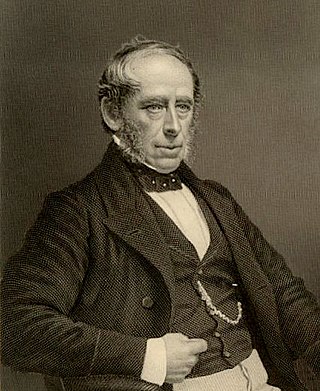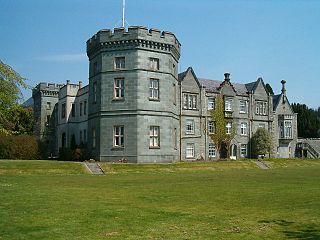Related Research Articles

Marquess of Aberdeen and Temair, in the County of Aberdeen, in the County of Meath and in the County of Argyll, is a title in the Peerage of the United Kingdom. It was created on 4 January 1916 for John Hamilton-Gordon, 7th Earl of Aberdeen.

Marquess of Winchester is a title in the Peerage of England that was created in 1551 for the prominent statesman William Paulet, 1st Earl of Wiltshire. It is the oldest of six surviving English marquessates; therefore its holder is considered the premier marquess of England. It is also now the only marquessate in the Peerage of England not being subsidiary to a higher title. The current holder is Christopher Paulet, 19th Marquess of Winchester, whose son uses the courtesy title Earl of Wiltshire.

Viscount Cobham is a title in the Peerage of Great Britain that was created in 1718. Owing to its special remainder, the title has passed through several families. Since 1889, it has been held by members of the Lyttelton family.

Earl of Verulam is a title in the Peerage of the United Kingdom. It was created in 1815 for James Grimston, 4th Viscount Grimston. He was made Viscount Grimston at the same time. Verulam had previously represented St Albans in the House of Commons. In 1808 he had also succeeded his maternal cousin as tenth Lord Forrester. He was succeeded by his son, the second Earl.

Baron Vernon, of Kinderton in the County of Chester, is a title in the Peerage of Great Britain. It was created in 1762 for the former Member of Parliament George Venables-Vernon. He had previously represented Lichfield and Derby in the House of Commons. Born George Vernon, he was the son of Henry Vernon, of Sudbury in Derbyshire, and Anne Pigott, daughter and heiress of Thomas Pigott by his wife Mary Venables, sister and heiress of Sir Peter Venables, Baron of Kinderton in Cheshire. In 1728, he assumed by Royal Licence the additional surname of Venables upon inheriting the Venables estate in Cheshire from his childless cousin Anne, widow of the 2nd Earl of Abingdon.

Baron Bolton, of Bolton Castle in the County of York, is a title in the Peerage of Great Britain. It was created in 1797 for the Tory politician Thomas Orde-Powlett, who had previously served as Chief Secretary for Ireland. Born Thomas Orde, he was the husband of Jean Mary Browne-Powlett, illegitimate daughter of Charles Powlett, 5th Duke of Bolton, who had entailed the greater part of his extensive estates to her in default of male issue of his younger brother Harry Powlett, 6th Duke of Bolton.
Baron Ventry, of Ventry in the County of Kerry, is a title in the Peerage of Ireland. It was created in 1800 for Sir Thomas Mullins, 1st Baronet. He had already been created a Baronet, of Burnham in the County of Kerry, in the Baronetage of Ireland in 1797. The Mullins family claimed descent from the Norman De Moleyns family. The first Baron's grandson, the third Baron, resumed the alleged 'ancient' family name of De Moleyns by Royal licence in 1841. His son, the fourth Baron, sat in the House of Lords as an Irish Representative Peer from 1871 to 1914. Lord Ventry also assumed the additional surname of Eveleigh, which was that of an earlier ancestor. His younger son, the sixth Baron, married Evelyn Muriel Stuart Daubeny. As of 2014 the titles are held by their grandson, the eighth Baron, who succeeded his uncle in 1987. In 1966 he assumed by deed poll the surname of Daubeney de Moleyns.

Baron Hampton, of Hampton Lovett and of Westwood in the County of Worcester, is a title in the Peerage of the United Kingdom. It was created in 1874 for the Conservative politician Sir John Pakington, 1st Baronet.

Baron Hazlerigg, of Noseley in the County of Leicester, is a title in the Peerage of the United Kingdom. It was created in 1945 for Sir Arthur Hazlerigg, 13th Baronet. He had previously served as Lord Lieutenant of Leicestershire. As of 2023 the title is held by his great-grandson, the fourth Baron, who succeeded his father in 2022.
Baron Acton, of Aldenham in the County of Shropshire, is a title in the Peerage of the United Kingdom. It was created on 11 December 1869 for Sir John Dalberg-Acton, 8th Baronet, a prominent historian and Liberal Member of Parliament.

Baron Churston, of Churston Ferrers and Lupton in the County of Devon, is a title in the Peerage of the United Kingdom. It was created in 1858 for the former Conservative Member of Parliament, Sir John Yarde, 3rd Baronet. He had earlier represented South Devon in the House of Commons. Two years later, in 1860, he assumed by Royal licence the additional surname of Buller. As of 2023 the titles are held by his great-great-great-great-grandson, the sixth Baron, who succeeded his father in that year.

Kilmory Castle, also known as Kilmory House, is a large 19th century house located just to the south of Lochgilphead, in old county Argyll, on the west coast of Scotland. It is currently occupied by the headquarters of the Argyll and Bute Council. The gardens are open to the public and form part of a country park on the former estate. The house is protected as a category B listed building.

Baron Blythswood, of Blythswood in the County of Renfrew, was a title in the Peerage of the United Kingdom. It was created on 24 August 1892 for Sir Archibald Campbell, 1st Baronet, the former Member of Parliament for Renfrew, with remainder failing heirs male of his own to five of his younger brothers and the heirs male of their bodies.

Baron Calthorpe, of Calthorpe in the County of Norfolk, was a title in the Peerage of Great Britain. It was created in 1796 for Sir Henry Gough, 2nd Baronet, who had previously represented Bramber in Parliament. Born Henry Gough, he had assumed the additional surname of Calthorpe upon inheriting the Elvetham and Norfolk estates of his maternal uncle, Sir Henry Calthorpe, in 1788. The Baronetcy, of Edgbaston in the County of Warwick, had been created in the Baronetage of Great Britain on 6 April 1728 for Lord Calthorpe's father Henry Gough, who represented Totnes and Bramber in the House of Commons. He was the husband of Barbara, daughter of Reynolds Calthorpe. Three of Lord Calthorpe's sons, the second, third and fourth Barons, both succeeded in the titles. The latter sat as a Member of Parliament for Hindon and Bramber. In 1845 he assumed by Royal licence for himself the surname of Gough only. His eldest son, the fifth Baron, represented East Worcestershire in Parliament as a Liberal. The fifth Baron's younger brother, the seventh Baron, was a Lieutenant-General in the Army. The latter's son, the eighth Baron, was succeeded by his grandson, the ninth Baron. The titles became extinct on the death of the ninth Baron's younger brother, the tenth Baron, in 1997.
There have been two baronetcies created for people with the surname Heathcote, both in the Baronetage of Great Britain and both created in 1733. The holders of the first creation were later elevated to the peerage as Baron Aveland and Earl of Ancaster, which titles are now extinct. However, both baronetcies are extant as of 2008.

Thomas Orde-Powlett, 1st Baron Bolton PC was an English politician. He was also an amateur etcher, and a cartoonist.
There have been six baronetcies created for persons with the surname of Lawson, two in the Baronetage of England and four in the Baronetage of the United Kingdom. Two creations are extant as of 2010.

The Smith, later Bromley, later Pauncefote-Bromley, later Bromley-Wilson, later Bromley Baronetcy, of East Stoke in the County of Nottingham, is a title in the Baronetage of Great Britain. It was created on 31 October 1757 for the banker George Smith, High Sheriff of Nottinghamshire from 1757 to 1759. He was the eldest son of Abel Smith I (1686–1756) of Nottingham, the 2nd son of Thomas Smith I (1631–1699), the founder of Smith's Bank in Nottingham. His younger brothers included: Abel Smith II (1717–1788) and John Smith, ancestor of Julian Pauncefote, 1st Baron Pauncefote.
Lt.-Col. Sir Terence Edmond Patrick Falkiner, 8th Baronet DL KStJ was an English soldier.
William Henry Orde-Powlett, 3rd Baron Bolton DL was an English landowner.
References
- ↑ "No. 13221". The London Gazette . 24 July 1790. p. 465.
- Kidd, Charles, Williamson, David (editors). Debrett's Peerage and Baronetage (1990 edition). New York: St Martin's Press, 1990.
- Leigh Rayment's list of baronets